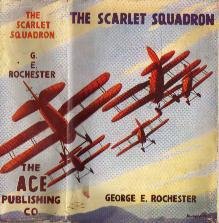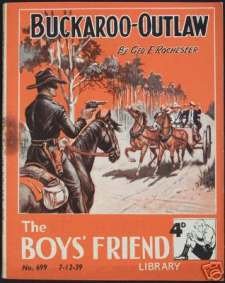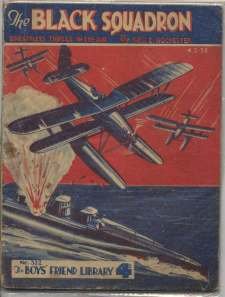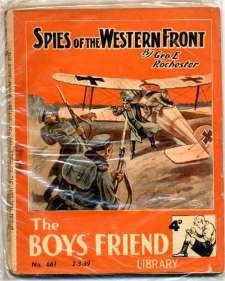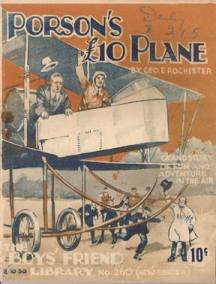| bc |
GEORGE
E. ROCHESTER
Most popular air
adventures author in the 1930s
Page updated 17th January, 2015.
Just ONE page on
the Collecting Books and Magazines web site based in Australia.
Additional input
supplied by Jim Mackenzie, Steve Holland, Robert
Crewdson,
David Ainsworth, Kim Miles, Hugh Shipman and Nick Lockie.
Thank you, all!.
See Jim's page at http://www.philian.pwp.blueyonder.co.uk/
George.E.Rochester Facebook page NEW!
SF
Encyclopaedia GER page
Bibliography
Including:
Adventures at Greystones, 1936
The Air Ranger, 1936
The Air Trail, 1936
The Black Bat rides the Sky, 1948
The Black Flag, nd
The Black Hawk, 1936
Originally
published in the Boys Friend Library (BFL) #237
(1.5.30) - Kim
The Black Mole, 1936
The Black Octopus, 1954
The Black Pirate, 1934
The Black Squadron, 1935
The Black Wing, 1951
Brood of the Vulture, 1936
Originally
published in BFL #282 ( 2.4.31) as The
Air - Kim
The Bulldog Breed, 1936
Buzzards Roost, 1955
Captain Robin Hood, Skywayman, 1935
Christine, Air Hostess (as
Mary Weston)
Dead Man's Gold, 1936
Derelict of the Air, 1937
Despot of the World, 1936
Drums of War, 1957
Fledgling Wings, 1952
The Flying Beetle, 1935
The Flying Cowboys, 1936
The Flying Fool, nd
The Flying shark, 1947
The Flying Spy, 1935
The Freak of St Freda's, 1936
Grey Shadow - Master Spy, 1936
The Greystones Mystery, 1950
Haunted Hangars, 1950
The Haunted Man, 1951 (as
Jeffrey Gaunt)
Jackals of the Clouds, 1936
The Lair of the Vampire, 1948
The Moth Men, 1950 |
The Mystery of the
Flying V Ranch, 1936
The Night Hawks, nd
North Sea Patrol, 1938
Phantom Wings, 1947
Pirates of the Air, 1936
Porson's Flying Service, 1936
The Return of Grey Shadow, 1949
The Scarlet Squadron, 1938
Scotty of the Secret Squadron, 1937
Scourge of the Skies, 1948
Secret Pilot, 1954
The Secret Squadron in Germany, 1938
The Shadow of the Guillotine, 1936
The Sky Bandits, 1938
Sky Pirates of Lost Island, 1937
Sons of the Legion, 1948
The S.O.S. Squadron (as
Hamilton Smith)
Sprig Dawson: Pilot, 1952
The Squadron without a Number, 1937
Tiger Hawk, 1949
The Trail of Death, 1936
Traitor's Rock, 1933
Vultures of Death, 1937
The Vultures of Desolate Island, 1938
White wings and Blue Water, 1952
Wings of Doom, 1936
Wings of the Night, 1948
The Worst Squadron in France, 1949Short stories in the following
books
Ace High, 1938
Air Adventures, 1938
Air Stories, 1938
Flying Adventures, 1936
Flying Stories, 1936
Flying Thrills, 1936
Out of the Blue, 1938
|
Story papers and comics
A Busman's Holiday (Tales of the Air / Master
Thriller #14, Sep 1936)
Desert Island Champion (Boys' Fun, Nov/Dec 1954)
Serial stories in KNOCKOUT
Here Comes a Sailor appeared in 367-386
Jack, Jill & Jollikins appeared in 387-422 + 431-449
Pocket libraries
(Note I've not yet included full details of 2 of the
above; have to find the original scans.)
The Black Raiders, BFL No. 291 (new series),
4.6.31
The Black Squadron, BFL No. 322 (new series), 4.2.32
The Trail of the Flying Bomb (with Edward Holmes as
George E. Holmes, Bullseye Library 701, 1940)
Spies of the Western Front BFL No.
Buckaroo Outlaw, BFL No.
The Flying Cowboys, BFL No. 437 (new series), 5.7.34.
Porson's £10 Plane, BFL No, 260 (new series), 2.10.30
It's also said that
Rochester was the author behind the pen-names John
Beresford and George E. Holmes, so these need to be added
to the list. See ADDITIONAL
INFORMATION at the end of the page.
Ending
it all.
The
Despot of the World
Reviewed
by Jim Mackenzie [To the right
you see issue number 16 of 'The Boy's Wonder
Library', no.16, dated 17th February, 1933. This
miniature pocket library measured a mere 11 x 16
cm and ran to 64pp plus cover.]
Who could fail
to be moved ? The prologue to “The Despot of
the World” is no tame introduction to the
characters, the places and the events that are
about to unfold in the pages that follow. The
opening words combine that note of melancholy and
wonder that Browning captured in “Childe
Rowland to the Dark Tower Came” and that
Coleridge used to grip us in “The Rhyme of
the Ancient Mariner”.
“Day is
almost done, and shades of the coming night are
creeping in across the restless sea to swathe in
grey shadow the silent dunes of sand. As I sit
here by my window I see again in the deepening
dusk that strange fantastic company of Castle
Grim.”
Is it a group
of medieval knights setting off on some sinister
but compelling quest ?
|
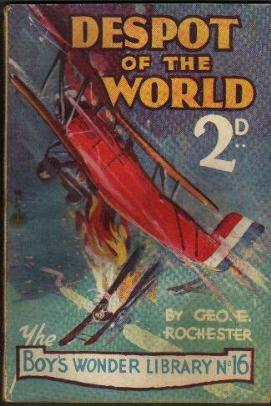 |
“They
pass before me, a phantom host, but I can name them all:
the cruel and merciless Zanderberg, warped of mind and
body, yet brilliant of wit; the gentle Guillaume, scarred
by the knout, crippled by the fetters, yet with the hint
of gallant laughter in his weary eyes; the brutal
Borstorge.”
As the
narrator drifts into this dream of the past, he takes the
reader with him until all the thoughts of the sad
storyteller begin to group around his own “familiar
friend” and a quest that was “the most perilous
and most tragic of them all.”
And so a
giant shadow already hangs over this story of the flying
adventurer, Harry Davies, the Flying Beetle. The reader
knows that, whatever difficulties are overcome and
whatever triumphs are achieved, death awaits the hero.
The book’s success lies in its tone – an
impenetrable sadness that pervades it from the first.
And, at the end, is also a turn of the plot that I dare
not give away – a sacrifice that is both wonderfully
upsetting and tragically uplifting.
Beverley,
the storyteller, has enough horrific adventures of his
own to make the reader forget for a while that is the
destiny of the Flying Beetle that should be the centre of
our concerns. The story opens in Alnmouth in
Northumberland (Rochester’s own birth-place) where
the message comes to Major Beverley from a ship’s
captain who has docked in Amble . He has walked the six
miles in a gale of wind and driving rain merely to
deliver his urgent message. I have walked the very road
he must have struggled along. I have seen the breakers
smash up the beach in a storm. I have seen a lonely house
that could have been Berverley’s own dwelling.
It’s all clear to me.
To Danzig
and then to Zilsen is the first lap of our
narrator’s pilgrimage to Castle Grim, the particular
dark tower of this story. In Zilsen Beverley is forced to
wait for the Beetle’s message. It is a staging post
in the journey and Rochester suddenly leaves his story
behind for a while and takes us on a walk towards a place
called Pillau. There he describes “an encampment of
long, black huts.”
Beverley
inquires of an old bearded man what place it was. It was
the “lonely camp to which British officers and men
had been sent when the tide of war was turning against
Germany on the western front.” A footnote reveals
that Rochester was a prisoner-of-war in this particular
camp and he gives a chilling reminder of what it was
really like “And here had been spent the long weary
days, the endless shivering nights, until release had
come.” It is clear that autobiography has escaped
into fiction.
True, this
episode does not develop the action of the story one jot
but it does achieve something else. Its genuine feelings
counter some of the more artificial aspects of his
characterisation of a stereotypical bad German. It also
introduces that prevailing environment of bleakness,
chill and deadly cold that underline the misery and
suffering that is to come.
Flying
adventures in the form of aerial combats are here in two
strong doses. A journey to the heart of Siberia involves
encounters with the Soviet Air Force. Journeys in open
cockpits have you shivering and shaking in instinctive
sympathy as Beverley ploughs on over frozen rivers,
jagged mountains and endless prairies of snow. That hardy
annual of boys’ stories - the attack of the starving
wolves from out of the forest is given a new twist.
Later a
full-scale battle between squadrons of Red Communist
fighters and the pirate squadron leaves you uncertain
about which side you want to win. Beverley finds a
comradeship with the very men that he is meant to be
defeating and a champion in the man who earlier he
believed wanted to kill him.
Yet all of
this is just a prelude to the climax where the only man
who can wreck the Flying Beetle’s plans is Beverley
himself!
The story
holds you to the end – in spite of the exaggerated
characters and the “world-domination” plot. You
are left with the tragedy of Harry Davies, “one
whose gallant soul has gone to meet the greatest Dawn of
all.” It was inevitable perhaps that even as
Rochester called out like Browning’s Knight Roland
that all was “Lost, lost !” the first clamours
came in to bring the Beetle back to life.
But
that’s another story.
The
Scarlet Squadron
(Published by The Ace Publishing Company, London.)
Reviewed by your editor.
This is said to be GER's best story. I can well
believe the statement as I found it as good as any
Biggles tale. The story concerns Major Beverley, an agent
sent in search of fellow British Secret Service agent
Harry Davies, 'The Flying Beetle' who has disappeared in
the region of the Gobi Desert. GER wastes no time in
moving his hero across the world; it's done in a few
sentences. Davies had been despatched to China to
investigate reports of a foreign power stirring up the
locals to act against the Empire. This may read a touch
too dramatic for the story itself is told in a matter of
fact style for the greater part. There is little dated
slang and events move along nicely with plenty of often
underplayed action. One memorable event is an
interrogation which GER points out was based on his own
experience during the Great War. There isn't as much
aerial action as one would expect which is a pity. These
scenes are so beautifully written that you will feel as
though you are up there in the Blue. A timeless story
which should appeal to anyone who can find a copy.
Porson’s
Flying Service
(Published by the Popular
Library, London.) Reviewed by Jim Mackenzine.
This 1935 book seems to catch the essence
of an even earlier age. It is essentially a collection of
short stories strung together around the concept of a
young man determined to make his way in the world and
eventually found his own airline. The odds against him
seem formidable – he has started his great
enterprise with just a Maurice Farman biplane.
“Remember it had been built in the
dark ages of flying, but by a great pioneer. It was a
cumbersome-looking machine, yet its bamboo framework body
gave to it a certain air of frailty. It was practically a
glider, fitted with a 35 horse-power Green engine driven
by a pusher propeller.”
It cost George Porson just £10. This
price would seem to indicate that this book is a
re-working or even a reprinting of “Porson’s
£10 Plane” that was published in 1930.
George’s father is off big-game
hunting in Africa but his Aunt Elizabeth is there to
ensure that the seventeen year old doesn’t waste his
time on an impossible venture. She has arranged for him
to join a bank run by Messrs. Grubbins and Grime (That
sounds a promising career !) and, peering at him severely
through her lorgnette, tries to make him bow to her will.
He will not get a penny from her when his business goes
bust.
“’I shall not fail !’
replied Porson, with sublime confidence.” His first
attempt to win some money to keep going occurs at
Tuttleberry-cum-Hacklehurst when he enters a competition
run by the local flying club. Up against a
“frightfully posh sort of crowd”, who fly up to
date Avro Avians and Blackburn Bluebirds, he succeeds in
winning the game of flying golf by dropping his sand-bomb
within a yard of the target. His slow flying machine
actually gave him an advantage. One of the snobby
“toffs” had called him a “flying
pauper” but has to pay off a bet he made by becoming
Porson’s mechanic and helper for a week.
The adventures that follow are suitably
diverse and include catching a country-house thief who
uses a balloon as a means of getaway, chasing a runaway
tiger with a mad aristocrat on board, catching poachers,
and making sure that a prize hen gets safely to a poultry
show !
Porson’s companions include his
little dog, Bill, who always jumps on board the Farman
just before take-off. He is also on good terms with
Gaffer, a local member of the working classes, who proves
to be the “salt of the earth”.
Amongst the most amusing incidents is the
one concerning the test parachute where it appears one of
George’s fattish passengers is hell-bent on suicide.
At the other extreme Rochester suddenly achieves a
remarkable change of tone in the chapter “Taking it
out of Cuthbert” where Cuthbert Crawford-Carter who
had sneered at WW1 pilots is suddenly confronted by his
own failure to fly the Farman properly. George’s
friend, Woolerton, then tackles Cuthbert with an even
more unpleasant accusation:
“Did you know, you beast, with your
sneering talk of the old War pilots, that Porson’s
brother was a War pilot – that he died in France ?
And did you know how he died ?”
It turns out that that Porson’s
elder brother had stuck with a riddled and blazing
machine in order to save his observer who was wounded in
the rear cockpit. And the name of the observer who
survived was that of Cuthbert’s own brother.
Woolerton finishes with, “And Porson never told you
– although he knew.”
Elsewhere in the stories there are
accounts of snobs and toffs getting their come-uppance,
though some of George’s friends also prove to be
first-class chaps even though they have titles. At times
it is rather like P.G.Wodehouse’s Bertie Wooster had
bought an aeroplane and the entire Drones Club had taken
up
flying.
However, there are also plenty of flying
sequences with the Farman constantly on the brink of
disaster and some very good birds-eye view descriptions
of countryside. There are also four illustrations by
Stanley Orton Bradshaw. Each one is black and white and
the best is the frontispiece which shows the Maurice
Farman in a steep dive just above the metals of a railway
line with a train thundering towards the point of impact.
To find out what happens you must read the book.
It must be admitted that the plotting and
characterisation are superficial but the aeroplane
details and the liveliness of the writing give the
promise of something better to come.
G.E.R.
Timeline
Here's a concise timeline for GER, gleaned from a lengthy
article in the December 1972 issue of Antique Book
Monthly. There is a good article in THIS ENGLAND but I've
missing the issue date. This was penned by the authority
on GER, Bob Whiter, of the London OB Book Club, now
residing in Los Angeles. Further updated information has
kindly been supplied by Robert.
Thanks, Robert.
17 Dec 1898 - Born
Alnmouth, Northumbria, UK, to George Rochester and
Christina Jane Robinson.
29 Jan 1918 - Enlisted as a Cadet, Royal Flying
Corps.
18 May 1918 - Granted a Commission as
Temporary 2nd Lieutenant in the Royal Flying Corps, 18th
May, 1918. (Service number 10901). Later: Posted to 97
Squadron: observer, rank of Flight Lieutenant, 12
shillings a day plus flying pay of 8 shillings a day. 7
pounds a week, quite a tidy sum back then.
3 Aug 1918 - 97 moved to Xaffervillers, France.
18 Aug 1918 - George's Handley Page
0/400 was shot down by anti-aircraft guns, 13 ks behind
the German lines. Number 97 squadron lost 2 planes on
this night; all 4 airmen were captured and made prisoners
of war. George was interned in various camps, the seventh
being Landshut, Bavaria. Where W E Johns was interned.
15 Apr 1919 - Transferred to the unemployed
list.
31 Aug 1921 - Relinquished Commission
and permitted to retain the rank of 2nd Lieutenant.
1924 - Married at Morpeth,
Northumberland, to Dorcas Shotton. Dorcas was born in
1903.
1925? Wrote a short WW1 tale, THE FUNK, and sent
it off to the BOP (Boy's Own Paper). Editor G R
Polklington published it early in 1926 and requested a
full-length story. THE FLYING BEETLE used the same
character as THE FUNK: Harry Davies.
1926 - George began writing for D C Thompson's VANGUARD but the stories were published anonymously. All
records have since been destroyed.
1927-8 - George started work on THE SCARLET
SQUADRON. This opened vol.50 of the BOP. He was voted the
Most Popular Contributor to the BOP by the proverbial
mile.
1928 - George began writing for THE POPULAR and
NELSON LEE and of course CHUMS. THE MODERN BOY from issue
12 became George's 'home' until the very end of that
famous paper.
1928-9 - THE VULTURES OF DESOLATE ISLAND opened
vol.51 of BOP. George also began writing for THE MAGNET
in 1929, anonymously at first. These stories would
reappear, sometimes abridged, in BOY'S FRIEND LIBRARY.
1929 - Moved to Broadstairs, Kent, UK, home of
John Buchan and, somewhat earlier, Charles Dickens. His
home, 'Jutland' was in Lindenthorpe Road. After a year he
moved to 58 St George's Rd.
1929-30 - THE DESPOT OF THE WORLD opened vol.52
of the BOP. He tried to write Harry Davies off but like
Sherlock Holmes, public opinion would eventually see this
hero reappear.
1930s - Wrote for RANGER, PILOT, THE GEM,
ADVENTURE, WIZARD, etc. Four years after Harry Davies'
apparent death, THE RETURN OF THE FLYING BEETLE brought
him back. BOP vol.56. This never appeared in book form -
in Britain, at least.
1932 - Daughter Anne born.
1933 - First hardback novel, TRAITOR'S
ROCK published by Eldon Press. The Times Lit. Sup of June
29: "The story of the war is original in both plot
and setting; also, it is written with literary
ability."
1934 - Began writing SEXTON BLAKE stories under
the pseudonym of Jeffrey Gaunt for DETECTIVE WEEKLY.
1935 - Came to the attention of John Hamilton,
who published 16 titles of his in 1936. It was announced
that he was the most popular writer of flying stories.
July 1936 - THE BULLDOG BREED was
semi-autobiographical, the hero, Eric Milvain being a
member of 97 Squadron. THE SHADOW OF THE GUILLOTINE was
George's one historical novel.
1939 - Back in uniform in the RAF Regiment for
airfield defence. He was still writing for DETECTVE
WEEKLY but the blitz destroyed his own collection of this
paper.
22 May 1941 - Re-enlisted as 1500878 Aircraftman
2nd Class Royal Airforce Volunteer Reserve.
1941 - John Hamilton's offices were
destroyed in a bombing raid, finishing that publisher
forever.
9 Oct 1941 - Discharged on appointment to
Commission.
10 Oct 1941 - Granted an Emergency
Commission as Acting Pilot Officer on probation in the
Administrative and Special Duties Branch, Royal Airforce
Volunteer Reserve.
10 Dec 1941 - Graded as Pilot Officer on
probation.
1 Aug 1942 - Acting Flight Lieutenant.
1 Oct 1942 - War Substansive Flying
Officer on probation. Confirmed in appointment on same
day.
15 Mar 1944 - Relinquished Commission in
Royal Airforce Volunteer Reserve on account of
ill-health, and permitted to retain rank of Flight
Lieutenant.
1946 - Demobbed and moved to 27 Berkely
Drive, West Molesey, Surrey, UK. Signed a 5-book contract
with Lutterworth Press. PHANTOM WINGS appeared in the BOP
and in book form in 1947.
1947 - Signed with Lutterworth for another book
and one per year option. THE FLYING SHARK was published
in Norway as well as the local 10,026 first, and a first
reprint run. George's three 1948 books came from Charles
Daniels of Bovey Tracey. Daniels had been an editor of
WINGS. The same year he signed another 5-book contract,
this time with Hutchinson. These were, however, for girls
and were written under the name of Mary Weston. Only one
title, CHRISTINE-AIR HOSTESS, appeared, probably as very
few copies were sold. This is his scarcest book. His only
other girls' book, WHITE WINGS AND BLUE WATER, from
Warne, 1952, fared much better. A Canadian edition was
published by S J R Saunders of Toronto.
1951 - Eldon Press published THE HAUNTED MAN,
ex-DW as Jeffrey Gaunt.
1952 - Lutterworth published SPRIG DAWSON-PILOT,
and did not take up their option. This was their last GER
book.
1953 - George wrote two stories for WESTERN
LIBRARY MONTHLY.
1954 - Epworth published SECRET PILOT, a sequel
to BLACK WING, 1951.
1950s - He wrote for DANDY, BEANO, COMET and SUN
but refused commissions to write for comic strips.
1952 - George Rochester's wife, Dorcas, died in
1952 at Canterbury, Kent, aged 49.
1955 - Sadly, George was discovered
living in poor circumstances in a basement flat behind
Victoria Station.
1950s - He continued to write as Elizabeth Kent,
Hester Roche and Allison Frazer for women's publications
such as MIRACLE.
1957 - Warne published his last known book,
DRUMS OF WAR, set at the end of the American Civil War.
1962 - George suffered a stroke which left him
partly paralysed. After his stroke he went to live with
his daughter Christina, in Georga, USA. He was never
settled there, and was brought back to England and placed
in a nursing home for officers of World War 1, where he
met his old Captain..
23 March 1966 - George Ernest Rochester died of
a stroke, aged 68, having returned to Portsmouth Rd,
Putney, UK with his daughter. Even the local paper
ignored his death.
Additional Information
kindly supplied by Robert.
Note from your page
editor. The following hasn't been put into any type of
clear order yet, as it seemed more important to list it
immediately for further discussion and investigation.
A letter from Bill
Lofts dated 6th May,1988, says....."I imagined
he (Rochester) moved around a lot to dodge creditors, and
from what I gather owed money everywhere and was possibly
bancrupt. I do know that he probably only got a few
pounds a week from his writings, as most was seized by
liquidator. He had fled from Broadstairs, and I was
really most fortunate in ever contacting him"
A letter from Bill Bradford of 3rd
February,1995, says...."Bill Lofts told me Rochester
was living in poverty stricken conditions. I tackled,
discreetly, Christina when she came here, but she denied
this and just said he just did not bother after his wife
died. Her sister, who came a year later indicated that he
loved gambling and had heavy drinking sessions when funds
were available"
On a different note. According to his
daughter Christina Whitehead, he wrote straight onto a
typewriter and if he made a mistake, he would retype the
whole thing. At one time he had two secretaries, one of
these was the sister-in-law of the British band leader
Harry Roy. Christina also says that his comic strip
Mickey Pal the Wizard, which ran in the Knockout, put her
and her sister through school.
That is all I have on George Rochester;
now for some items not recorded by Bill Bradford.
Boy's Own
Paper vol 69. 1946-47. Serialisation of
Phantom Wings. A Flying Beetle story.
Boys Wonder Library.
No.1. The Squadron of Death.
No.16. The Despot of the World. (a Flying Beetle story).
No.24. The Air Patrol.
No.25. The Vultures of Desolate Island (a Flying Beetle
Story).
No.26. The Shadow of the Guillotine (as Frank Chaltam)
Chums volume 37.
issue 1875. The Abbot of Scrale. (as Frank Chaltam)
issue 1876. The House of Shadows. (as Barton Furze)
issue 1876 Keepers of the Convents. (as Frank Chaltam)
issue 1878. Derelicts of the Air. (as Frank Chaltam)
issue 1881. Gallows Inn (as Frank Chaltam)
The Thriller.
The Drifter. Serial in issues 485-488. 1938.
Every Boy's Annual. Published by
Juvenile Productions. Circa 1950.
Contains 'That Cad Cardew' by G.E.R.
As above circa 1951. Contains 'Hobson's Hobby' by G.E.R.
Rochester also wrote in the Sun
comic. I have one issue. I know they have been indexed,
is this is available on the Net.
A poem by Rochester entitled 'The Breed
of the Lion' appears in Modern Boy,
issue 12, dated April 28th, 1928.
I have searched vols 1-5 of Popular
Flying in the hope of finding something by
Rochester, but so far no luck. The long running series
Thrilling Flights continued after Johns published his
book of the same title.
Modern Boy was
incorporated into Boys Cinema; did
Rochester's stories carry over into this paper?.
Aero Digest From: danny@ynnad66.freeserve.co.uk
(David)
I have seen a cutout article from a US magazine called
Aero Digest. Volume 42, no. 4 dated April 1943 pages 212
and 265 has an article "British propeller
development" by Flight Lieutenant George E
Rochester.
|
bc |

